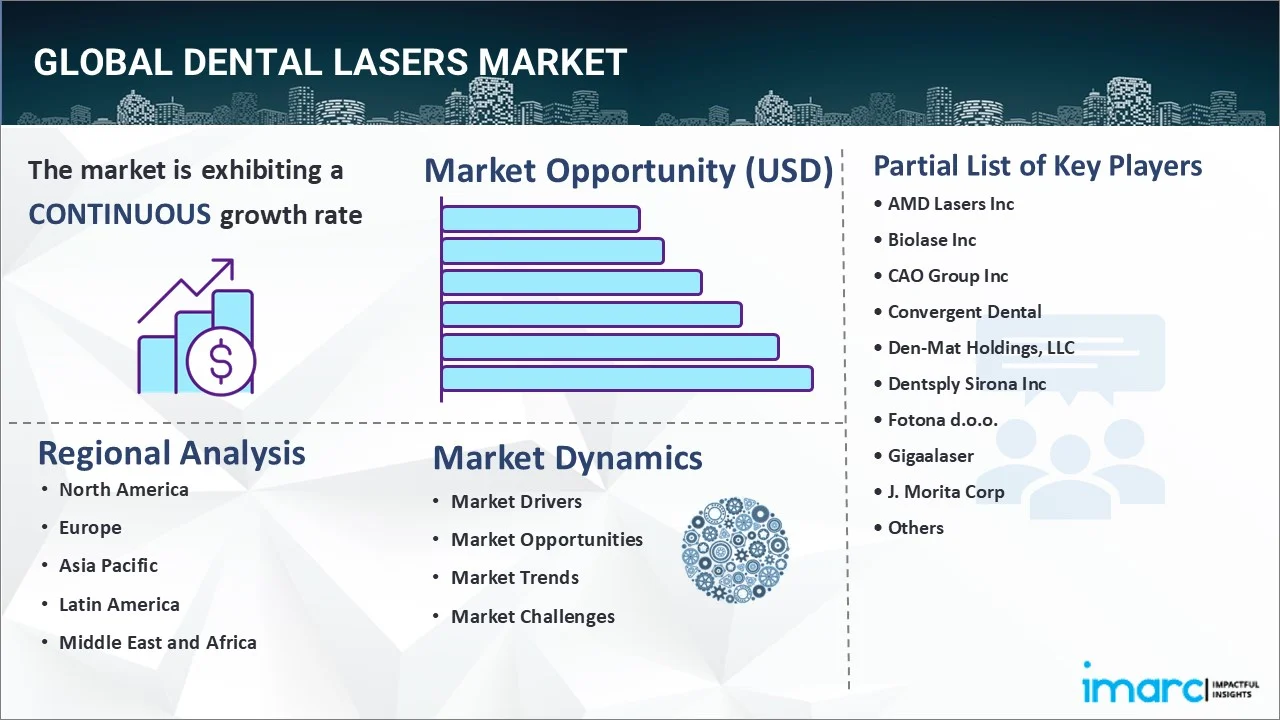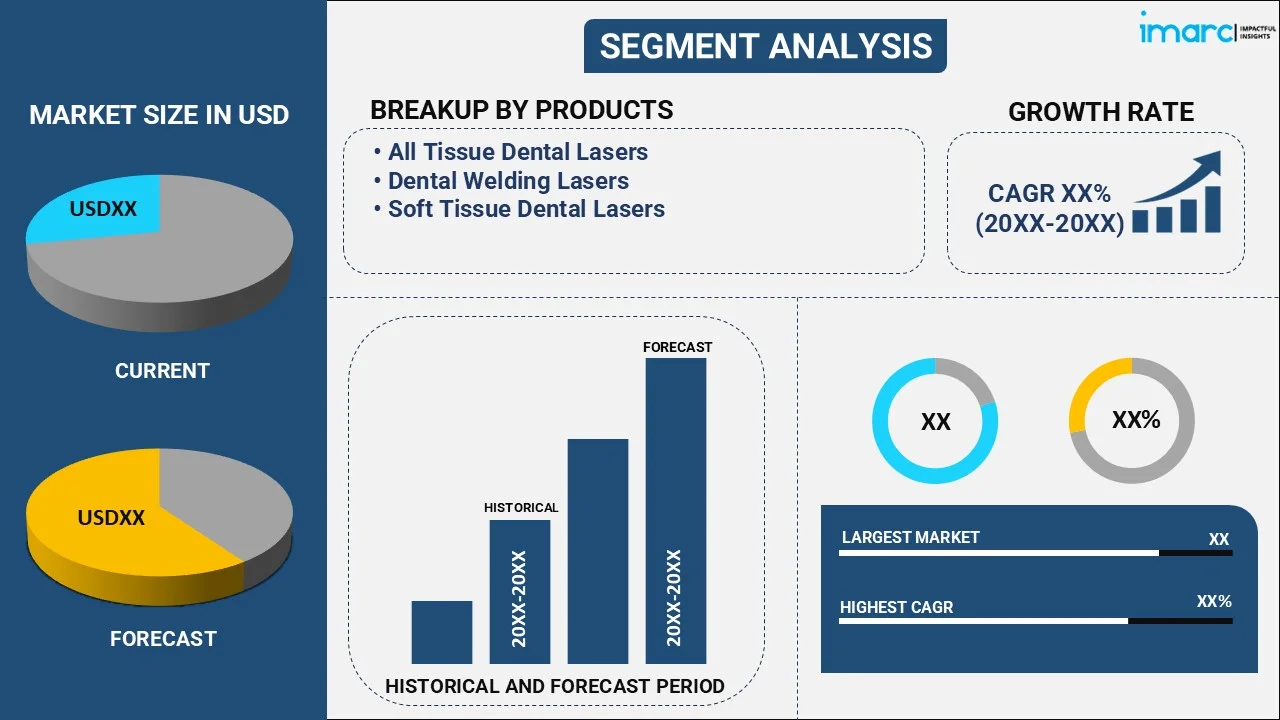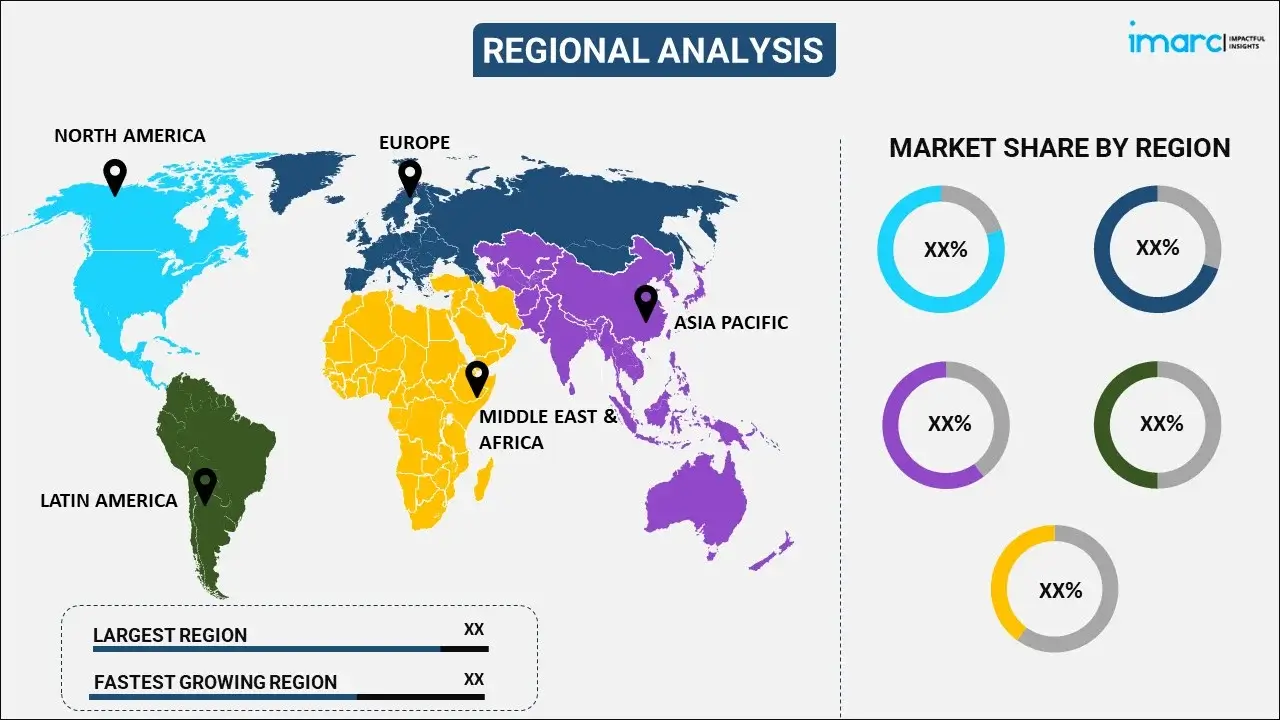
Dental Lasers Market Report by Product (All Tissue Dental Lasers, Dental Welding Lasers, Soft Tissue Dental Lasers), Application (Conservative Dentistry, Endodontic Treatment, Oral Surgery, Implantology, Peri-Implantitis, Periodontics, Tooth Whitening), End Use (Hospitals, Dental Clinics, and Others), and Region 2025-2033
Market Overview:
The global dental lasers market size reached USD 389.9 Million in 2024. Looking forward, IMARC Group expects the market to reach USD 612.7 Million by 2033, exhibiting a growth rate (CAGR) of 5.10% during 2025-2033. The increasing prevalence of dental disorders among the masses, considerable rise in dental tourism, particularly in developing economies, and continual advancements in laser technology, such as improved precision and reduced invasiveness are some of the major factors propelling the market.
|
Report Attribute
|
Key Statistics
|
|---|---|
|
Base Year
|
2024 |
|
Forecast Years
|
2025-2033
|
|
Historical Years
|
2019-2024
|
| Market Size in 2024 | USD 389.9 Million |
| Market Forecast in 2033 | USD 612.7 Million |
| Market Growth Rate 2025-2033 | 5.10% |
Dental lasers refer to a class of precision devices in dentistry that employ focused beams of light to efficiently perform a range of procedures while minimizing patient pain and discomfort. They are characterized by adjustable power settings, wide range of wavelengths of light, precise control for targeted treatment, sterilization, and non-contact operation. Dental lasers use focused light beams to interact with target tissues, causing various output such as cutting, vaporizing, or modification of the tissues through energy absorption. Hard tissue lasers are primarily utilized for tooth structure procedures, while soft tissue lasers are used for gum treatments, and dual-wavelength lasers are used for versatile cases.

The global market is primarily driven by the rising prevalence of numerous dental disorders, such as cavity, dental caries, periodontal diseases, and oral lesion. In line with this, the increasing awareness among the masses regarding the benefits and clinical applications of dental lasers is providing an impetus to the market. Moreover, the growing emphasis on patient comfort and experience is resulting in the shifting consumer preference for minimally invasive procedures, thereby fueling the market. In addition to this, the increasing popularity of dental tourism, particularly in developing economies, is propelling the demand for dental lasers. Some of the other factors contributing to the market include introduction of favorable reimbursement policies by insurance providers, rising medical expenditure and extensive research and development (R&D) activities.
Dental Lasers Market Trends/Drivers:
Augmenting demand for minimally invasive dental procedures
As a result of the growing demand for minimally invasive dental procedures in recent years, there has been a sharp rise in their use. There has been a resurgence in the use of dental lasers as an alternative to traditional techniques such as drilling and surgery in recent years. Dental lasers are designed to provide dentists with an accurate and controlled interaction with tissue, which allows them to perform procedures with minimal discomfort and trauma for patients. The increased preference for less invasive treatments is attributed to the fact that dental lasers reduce the need for anesthesia, minimize pain, and promote faster healing as a result of reducing anesthesia. The patient-centric approach of the dental lasers has led them to be adopted more widely in dental practices, as it meets the demand for procedures that are less invasive and more comfortable for the patient.
Continual advancements in laser technology
Technological advancements in laser technology are driving the market for dental lasers and enhancing their performance, precision, and safety. The utilization of modern technology, such as 3D printing and dental lasers have improved efficiency and precision, thereby improving accessibility to high-end dentistry services. As laser systems have become smaller, portable, and more user-friendly, they are becoming more accessible to dental professionals allowing them to be integrated into their practices more easily. By utilizing lasers for dental procedures such as cavity preparation and gum disease treatment, as well as cosmetic procedures such as teeth whitening, the range of procedures that can be performed with lasers has been expanded. Dental lasers' improved capabilities not only facilitate more efficient treatment, but also improve patient outcomes, thus propelling the market for these devices.
Rising need for precision treatment facilitating tissue preservation
One of the major market drivers of dental lasers is the availability of precise and targeted treatment for a wide range of conditions. There are certain techniques that dentists can use to selectively remove or modify tissue while causing no harm to adjacent healthy tissue surrounding the area. Procedures such as cavity preparation, gum disease treatment, and soft tissue surgery benefit from this level of precision. With dental lasers, collateral damage is minimized, and healthy tissue is preserved, resulting in better treatment outcomes and quicker healing times. In order to address oral health issues with greater accuracy and efficiency, dentists need dental lasers to perform precise and controlled treatments.
Dental Lasers Industry Segmentation:
IMARC Group provides an analysis of the key trends in each segment of the global dental lasers market report, along with forecasts at the global, regional, and country levels from 2025-2033. Our report has categorized the market based on product, application, and end use.
Breakup by Product:

- All Tissue Dental Lasers
- Dental Welding Lasers
- Soft Tissue Dental Lasers
Soft tissue dental lasers dominate the dental lasers market
The report has provided a detailed breakup and analysis of the dental lasers market based on the product. This includes all tissue dental lasers, dental welding lasers, and soft tissue dental lasers. According to the report, soft tissue dental lasers represented the largest segment.
Soft tissue dental lasers enable minimally invasive procedures, such as gum contouring, gingivectomy, and periodontal treatments. As a result, it is preferred by healthcare professionals as they involve reduced discomfort, lesser bleeding, and accelerated recovery times in comparison to traditional techniques. Also, continual technological advancements, such as improved precision and enhanced patient comfort is contributing to the segment growth.
On the other hand, all tissue and dental welding lasers segment is driven by their ability of having precise control over tissue ablation, cutting, and coagulation, thereby making them highly versatile tools for various dental procedures. Furthermore, the use of all tissue and dental welding lasers provide a more comfortable and painless experience for patients, leading to high segment growth.
Breakup by Application:
- Conservative Dentistry
- Endodontic Treatment
- Oral Surgery
- Implantology
- Peri-Implantitis
- Periodontics
- Tooth Whitening
Conservative dentistry dominates the dental lasers market
The report has provided a detailed breakup and analysis of the dental lasers market based on the application. This includes conservative dentistry, endodontic treatment, oral surgery, implantology, peri-implantitis, periodontics, and tooth whitening. According to the report, conservative dentistry represented the largest segment
Conservative dentistry is mostly preferred by orthodontics and are largely adopted due to their focus on preserving natural tooth structure. Also, they facilitate minimally invasive procedures and is further supported by continuous technological advancements in dental laser technology, enabling precise removal of decayed tissue and improved cavity preparation. With the rising prevalence of dental caries globally, the demand for conservative dentistry, including the use of dental lasers, is increasing, thereby propelling the segment growth.
On the other hand, lasers provide precise control during endodontic procedures, oral surgeries, implantology, and periodontics, thereby facilitating better patient outcomes. This results in less tissue trauma, reduced bleeding, and minimal post-operative discomfort compared to traditional techniques, which fuels the growth of the segment.
Breakup by End Use:
- Hospitals
- Dental Clinics
- Others
Dental clinics hold a larger share in dental lasers market
A detailed breakup and analysis of the dental lasers market based on the end use has also been provided in the report. This includes hospitals, dental clinics, and others. According to the report, dental clinics accounted for the largest market share.
The main factors that are driving the growth of this segment are the increasing dental awareness and growing oral health expenditure. The integration of dental lasers in dental clinics allows for advanced treatment options, such as minimally invasive procedures, improved healing, and enhanced patient experience, which is driving the growth of the segment. Additionally, the cost-effectiveness and efficiency of dental lasers, with reduced complications and faster healing times, make them an attractive investment for dental clinics, contributing to revenue generation.
On the other hand, laser-based procedures in hospitals offer the advantages of reduced trauma, faster recovery, and shorter hospital stays compared to traditional surgical methods. Also, laser technology provides hospitals with advanced tools for various surgical procedures, enabling precise and less invasive interventions in affordable costs, thereby driving the growth of the segment.
Breakup by Region:

- North America
- United States
- Canada
- Europe
- Germany
- France
- United Kingdom
- Italy
- Spain
- Others
- Asia Pacific
- China
- Japan
- India
- South Korea
- Australia
- Indonesia
- Others
- Latin America
- Brazil
- Mexico
- Others
- Middle East and Africa
North America exhibits a clear dominance, accounting for the largest dental lasers market share
The report has also provided a comprehensive analysis of all the major regional markets, which include North America (the United States and Canada); Europe (Germany, France, the United Kingdom, Italy, Spain, and others); Asia Pacific (China, Japan, India, South Korea, Australia, Indonesia, and others); Latin America (Brazil, Mexico, and others); and the Middle East and Africa.
North America held the biggest market share since the region has a well-established medical infrastructure and strong regulatory bodies in the developed nations of United States and Canada. Therefore, the presence of clear regulations and guidelines ensuring the safety and efficacy of dental lasers is resulting in the higher product adoption.
Another contributing aspect is the increasing dental insurance coverage in the region, including the treatment plans involving dental lasers, thereby making dental lasers more accessible and affordable to a larger population.
Additionally, the availability of advanced dental technologies and well-equipped clinics are providing a boost to the demand for dental lasers in the region, including in dental tourism. Furthermore, strategic collaborations among dental professionals and laser manufacturers are driving the development of new dental laser technologies.
Competitive Landscape:
The top players in the market are heavily investing in research and development (R&D) activities to improve their laser systems. The leading companies are introducing advanced technologies, such as new wavelengths, improved power outputs, and enhanced treatment capabilities to drive widespread product adoption. In addition to this, they are also launching upgraded versions of existing laser systems with integrated treatment planning software and user-friendly interfaces. Moreover, the key players are also engaging in strategic partnerships and acquisitions to expand their market presence and enhance their product portfolio. Furthermore, the major companies are also conducing numerous training programs for dental professionals and awareness initiatives for the masses to spread information regarding the benefits of dental lasers.
The report has provided a comprehensive analysis of the competitive landscape in the global dental lasers market. Detailed profiles of all major companies have also been provided. Some of the key players in the global dental lasers market include:
- AMD Lasers Inc
- Biolase Inc
- CAO Group Inc
- Convergent Dental
- Den-Mat Holdings, LLC
- Dentsply Sirona Inc
- Fotona d.o.o.
- Gigaalaser
- J. Morita Corp
- Light Instruments Ltd
- LightScalpel LLC
- The Yoshida Dental Mfg. Co. Ltd
Recent Developments:
- In August 2022, Biolase Inc. announced partnership with postgraduate residency dental specialty programs throughout the U.S. and North America to grow awareness on the Waterlase technology.
- In November 2021, CAO Group, Inc. (CAO) launched SheerWhite In-Office Teeth Whitening Strips and SheerWhite Take Home Teeth Whitening Strips, which refer to the world's first in office and take-home teeth whitening strip system for dental practices respectively.
- In April 2023, Convergent Dental Inc. received a $40 million growth capital support from Trinity Capital Inc., which is a leading provider of diversified financial solutions to growth-stage companies. This investment is focused on driving the broad-based adoption of the company’s flagship product, Solea, that enables cavity prep to be performed anesthesia-free, as well as soft tissue procedures that are blood-free and suture-free with minimal post-op discomfort.
Dental Lasers Market Report Scope:
| Report Features | Details |
|---|---|
| Base Year of the Analysis | 2024 |
| Historical Period | 2019-2024 |
| Forecast Period | 2025-2033 |
| Units | Million USD |
| Scope of the Report | Exploration of Historical and Forecast Trends, Industry Catalysts and Challenges, Segment-Wise Historical and Predictive Market Assessment:
|
| Products Covered | All Tissue Dental Lasers, Dental Welding Lasers, Soft Tissue Dental Lasers |
| Applications Covered | Conservative Dentistry, Endodontic Treatment, Oral Surgery, Implantology, Peri-Implantitis, Periodontics, Tooth Whitening |
| End Uses Covered | Hospitals, Dental Clinics, Others |
| Regions Covered | Asia Pacific, Europe, North America, Latin America, Middle East and Africa |
| Countries Covered | United States, Canada, Germany, France, United Kingdom, Italy, Spain, China, Japan, India, South Korea, Australia, Indonesia, Brazil, Mexico |
| Companies Covered | AMD Lasers Inc, Biolase Inc, CAO Group Inc, Convergent Dental, Den-Mat Holdings, LLC, Dentsply Sirona Inc, Fotona d.o.o., Gigaalaser, J. Morita Corp, Light Instruments Ltd, LightScalpel LLC, The Yoshida Dental Mfg. Co. Ltd, etc. |
| Customization Scope | 10% Free Customization |
| Post-Sale Analyst Support | 10-12 Weeks |
| Delivery Format | PDF and Excel through Email (We can also provide the editable version of the report in PPT/Word format on special request) |
Key Questions Answered in This Report:
- How has the global dental lasers market performed so far, and how will it perform in the coming years?
- What are the drivers, restraints, and opportunities in the global dental lasers market?
- What is the impact of each driver, restraint, and opportunity on the global dental lasers market?
- What are the key regional markets?
- Which countries represent the most attractive dental lasers market?
- What is the breakup of the market based on the product?
- Which is the most attractive product in the dental lasers market?
- What is the breakup of the market based on the application?
- Which is the most attractive application in the dental lasers market?
- What is the breakup of the market based on the end use?
- Which is the most attractive end use in the dental lasers market?
- What is the competitive structure of the global dental lasers market?
- Who are the key players/companies in the global dental lasers market?
Key Benefits for Stakeholders:
- IMARC’s report offers a comprehensive quantitative analysis of various market segments, historical and current market trends, market forecasts, and dynamics of the dental lasers market from 2019-2033.
- The research study provides the latest information on the market drivers, challenges, and opportunities in the global dental lasers market.
- The study maps the leading, as well as the fastest-growing, regional markets. It further enables stakeholders to identify the key country-level markets within each region.
- Porter's five forces analysis assist stakeholders in assessing the impact of new entrants, competitive rivalry, supplier power, buyer power, and the threat of substitution. It helps stakeholders to analyze the level of competition within the dental lasers industry and its attractiveness.
- Competitive landscape allows stakeholders to understand their competitive environment and provides an insight into the current positions of key players in the market.
Need more help?
- Speak to our experienced analysts for insights on the current market scenarios.
- Include additional segments and countries to customize the report as per your requirement.
- Gain an unparalleled competitive advantage in your domain by understanding how to utilize the report and positively impacting your operations and revenue.
- For further assistance, please connect with our analysts.
 Inquire Before Buying
Inquire Before Buying
 Speak to an Analyst
Speak to an Analyst
 Request Brochure
Request Brochure
 Request Customization
Request Customization




.webp)




.webp)












